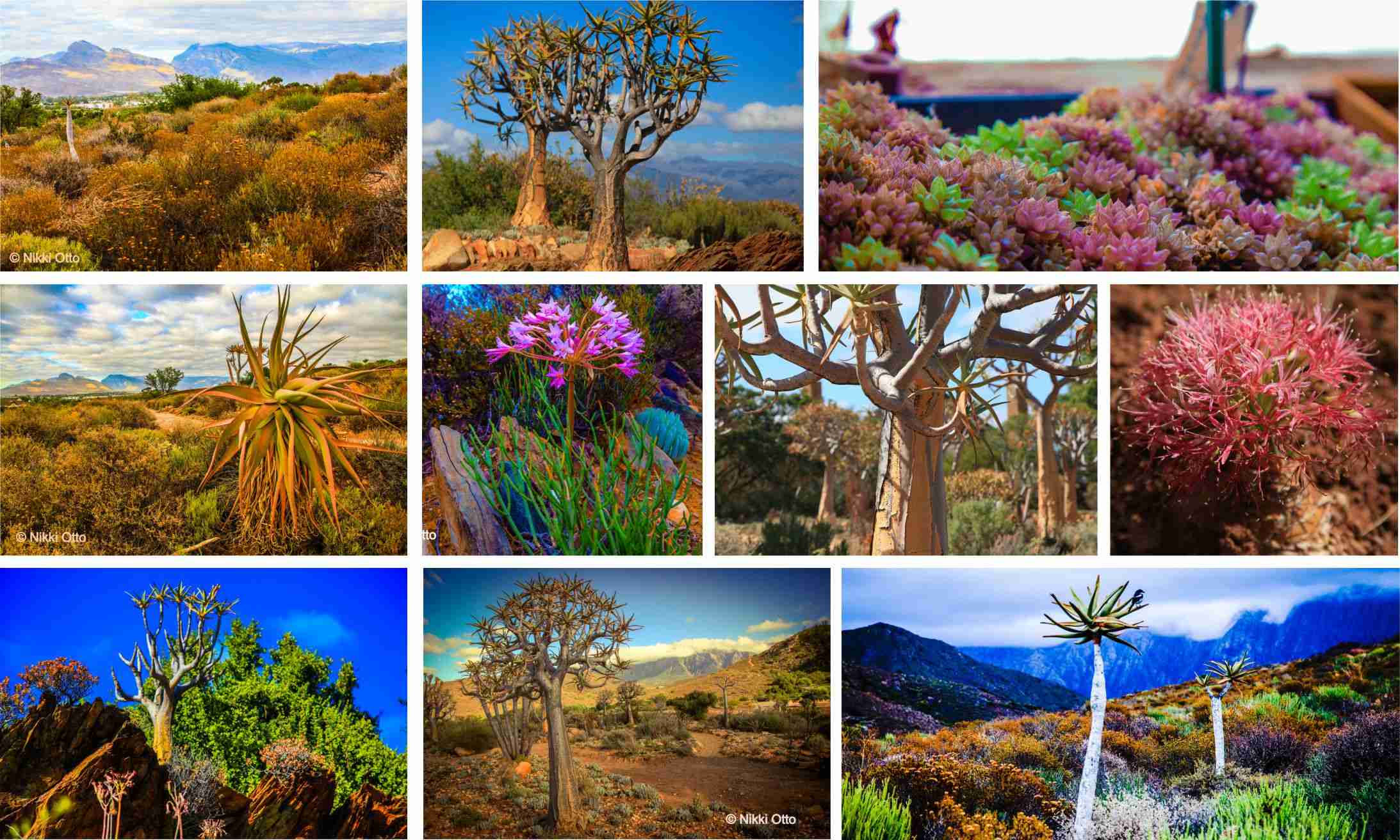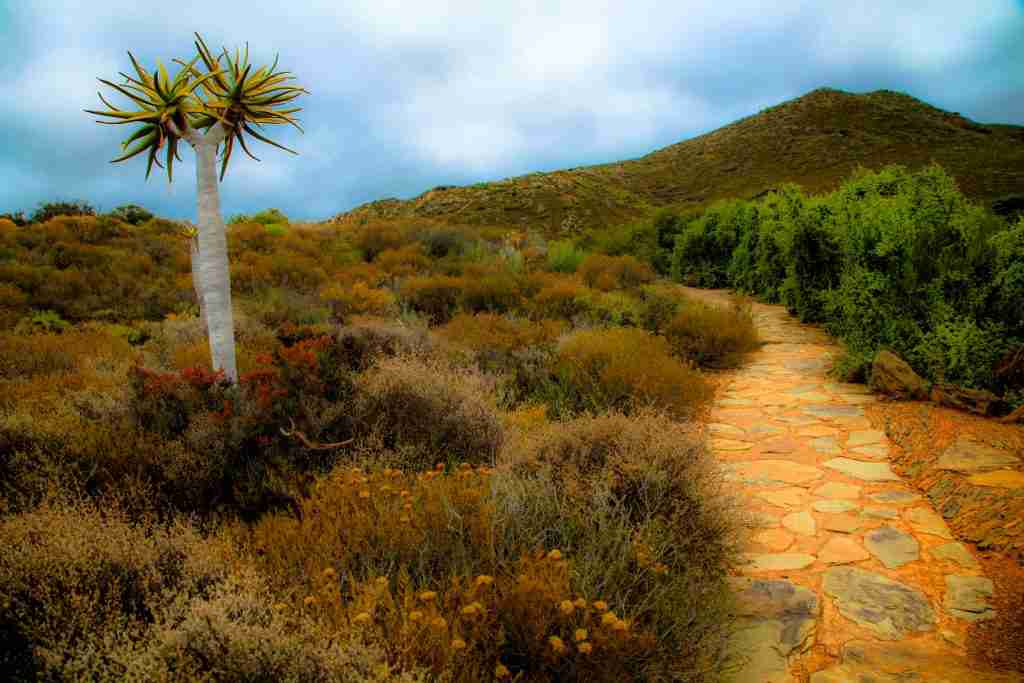In the Karoo Desert National Botanical Garden of South Africa, splendor can be found in every season.
http://www.sanbi.org/gardens/karoo-desert/
Despite the fact that it hasn’t rained for months, these gardens are well maintained, giving us a sanctuary in nature where we can escape the frenetic city to soak up the wonders of nature. Desert succulent flowers stand out as a reminder that we should always look for the beauty that surrounds us, even in the harshest environments.
The South Africa National Biodiversity Institute (SANBI) maintains 11 National Botanical Gardens throughout South Africa and, in the Karoo Desert National Botanical Garden, you can unwind in 154 hectares of arid and semi-arid vegetation that includes aloes, succulents and the famous quiver trees. The garden is located in Worcester, a short drive from Cape Town. Worcester, by the way, is home to the best fish and ‘slap’ chips on earth. You can also treat yourself to fresh farm produce including a decadent slice of top deck marbled cheesecake from the Barnyard Deli in town.
Ricardo Riddles has been with SANBI for 12 years and has recently become the curator of the Karoo Desert garden. His main function is to manage the business operations as well as maintain efforts to conserve our indigenous flora.
“SANBI’S mandate is to explore, reveal, celebrate and champion biodiversity for the benefit and enjoyment of all South Africans, which includes managing the National Botanical and Zoological Gardens as ‘windows’ to South Africa’s biodiversity for enjoyment and education,” says Ricardo.
As a young man, Ricardo had no idea that he would become a horticulturist one day. He recalls, however, that as a child in Still Bay, he was surrounded by plants, “I can remember my first job as a child was to pick dry proteas with my Gran. It was God’s intervention that put me on this path,” he says. I asked him a few questions that reveal this man’s gentle heart and knowledge.
What are your concerns about the future of South Africa’s Flora and Fauna?
“I am a bit concerned about our vegetation, especially regarding plant poaching and the authorities not providing enough support. Climate change is inevitable and we can only assist by identifying our critical species and bringing them to our botanical gardens, which act as a safe haven for the propagation and conservation of all endangered species.”
The rising demand in Asia is impacting South Africa’s rare species of succulents, explains Ricardo. “It has been described as ‘succulent fever’ when very small succulents and plants that look like bonsai are in demand by poachers.”
Traditionally, succulents have been used for herbal remedies, food dyes and hallucinogens. Conophytum succulents have sedative properties and are highly sought after, threatening populations in the wild. You can take a tour of the garden’s herbarium, which contains over 3 900 taxa of succulents and geophytes and horticulturists and botanists have pooled their knowledge to ensure that these tiny succulents have a helping hand with pollination, as well as preventing hybridisation by keeping them separate. Currently, the team is trying to identify where the confiscated rare and endangered succulents originated from so they can return them to their natural habitat.
What should we all be doing to help conserve our biodiversity in South Africa?
“Follow legislation by not removing plants from the wild, promote native flora in your garden and report illegal plant poaching.”
You can contact Cape Nature for assistance in reporting any illegal activity to do with nature and conservation. https://www.capenature.co.za/
Visitors can meander through 11 hectares of semi-arid and arid vegetation. Informational signs show facts that explain the unique plants of each desert region in the country, including Namaqualand and the Richtersveld. And if you feel energetic there are four trails available ranging from 1km to 4.7kms, including a Braille trail. The gardens also offer a picnic area, a heritage garden and a nursery focusing on water-wise plants such as succulents and aloes.
Are you aware of any aloe farmers locally?
“I only know of medicinal aloe farmers close to the Albertinia. Aloes can be a good investment if the farmer finds the right market.”
And it’s not just the staff at SANBI that are investing in our biodiversity. The candelabra lily is one plant of many that was rescued by a farmer near Vanrhynsdorp in 2004 when their vineyard was being extended.
It is known that these flowering lilies emit a strong scent at night that attracts moths. Sangomas often boil the bulbs of these candelabra lilies for divining purposes, although they are highly toxic.
The wild grape tree or Cyphostemma juttae has its own unique survival characteristics, like its white, papery, stripping bark that acts as reflectors in the heat of the day; its thick, fleshy stem and leaves act as super water tanks when there’s a drought.
These Karoo Desert gardens truly provide insight into the wonders of nature. For example the pork bush has traditionally been used to increase milk in lactating mothers. The leaves are also used to quench thirst, treat exhaustion, dehydration and heatstroke. Spekbooms are also known as carbon sponges because they absorb carbon dioxide, assisting us with global climate change.
How have climate change and global warming impacted South Africa’s vegetation in general?
“Climate change and the lack of water have already killed several South African species, not to mention the damage to the vegetation caused by animals seeking water.”
These photogenic giant quiver trees, also called Kokerbooms in Afrikaans, belong to the aloe family and are critically endangered. Ricardo is also a huge fan of these enigmatic trees. “I find them amazing; they look like plants from the dinosaur age. I just love how they are formed.”
San hunters made quivers by hollowing out of the branches of the quiver tree. Why is the bark perfect for this?
“Yes, this tree has a soft core which can be easily removed from the branch. It is ideal as the quiver is a light weight to carry with them on long hunting journeys.”
How has the Namaqualand floral display normally occurring in the middle of August until the end of September been received by visitors to your garden?
“Visitors love this display, it is more convenient for visitors from Cape Town to come and view these flowers than to drive all the way to the Northern Cape,” says Ricardo.
An array of vygies and other Namaqualand daisies will surround this quiver tree in spring and, for a month or so, the Karoo Desert will become an art studio.
“I hope to have inspired you to visit these remarkable gardens throughout the year and not just during the magical months. After all, how can we appreciate the valleys if we haven’t experienced the desert?” says Ricardo.
Nikki Otto is a freelance writer, photographer and blogger. She is passionate about telling stories about the extraordinary. Having produced narrative-driven television inserts for more than 15 years, she now concentrates on writing and photography. She recently started Marketing Narratives can’t wait to tell your story. Visit her website and follow her blogs https://readyfeet.wixsite.com/nikkiotto/blog and https://fineartamerica.com/profiles/nikkiotto-stilllifephotography/shop which offers gifts, home decor and lifestyle products online, ranging from metal art prints to scatter cushions and Yoga mats.


